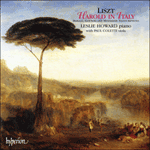This is the only Liszt work for piano and viola, apart from the
Harold transcription, and the broken chords which inform the coda to the
Romance oubliée are quite clearly an act of homage to the marvellous viola writing at the end of the Pilgrims’ March in
Harold. Indeed, the whole final section is a later addition to the
Romance oubliée, which was a reworking of an earlier piano
Romance of 1848, itself derived from the song
O pourquoi donc of 1843. The
Romance oubliée was Liszt’s response in 1880 to a request to reprint the earlier piano piece. He prepared it for the viola virtuoso Hermann Ritter, but also made versions (with different piano parts) for violin and for cello, as well as a new piano transcription.
from notes by Leslie Howard © 1993
C’est la seule œuvre de Liszt, à part la transcription de
Harold, pour piano et alto, et le grand nombre d’accords arpégés dans la coda de la
Romance oubliée sont sans aucun doute un hommage envers la magnifique écriture pour alto qui se trouve à la fin de la Marche des Pèlerins dans
Harold. En fait, toute la section finale est une adjonction ultérieure à la
Romance oubliée, qui était une recomposition d’une
Romance pour piano écrite en 1848, elle-même dérivée de la mélodie
O pourquoi donc de 1843. La
Romance oubliée était la réponse de Liszt, en 1880, à une demande de réimpression de l’œuvre pour piano précédente. Il la prépara pour l’altiste virtuose Hermann Ritter, mais fit aussi plusieurs versions (avec différentes partitions de piano) pour violon et pour violoncelle, ainsi qu’une nouvelle transcription pour piano.
extrait des notes rédigées par Leslie Howard © 1993
Français: Alain Midoux
Sie ist von der
Harold-Transkription abgesehen das einzige Werk, das Liszt für Klavier und Bratsche geschrieben hat, und die arpeggierten Akkorde, die der Coda ihr Gepräge geben, sind eine eindeutige Hommage an die herrliche Bratschenpassge am Ende des Pilgermarschs in
Harold. Übrigens wurde der ganze Schlußteil erst später an die
Romance oubliée angehängt. Sie selbst ist nämlich aus einer älteren Klavierromanze von 1848 hervorgegangen, und diese wiederum aus dem Lied
O pourquoi donc von 1843. Mit der
Romance oubliée reagierte Liszt 1880 auf die Bitte um eine Neuauflage des älteren Klavierstücks. Er bearbeitete es für den Bratschenvirtuosen Hermann Ritter und schuf gleichzeitig Versionen für Violine und Cello (mit jeweils anderem Klavierpart) sowie eine neue Klaviertranskription.
aus dem Begleittext von Leslie Howard © 1993
Deutsch: Anne Steeb/Bernd Müller


 Liszt: Complete Piano Music
Liszt: Complete Piano Music Liszt: The complete music for solo piano, Vol. 23 - Harold in Italy
Liszt: The complete music for solo piano, Vol. 23 - Harold in Italy
